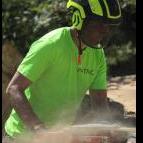Wow, like others have said that's an ambitious anchor. I usually use a cambium saver for srt (with an alpine butterfly and carabiner stopper) and I would be reluctant to tie to anything smaller than my fore-arm and I'm only 76kg.
Personally, If I'm not sure 100% of my anchor (dying tree or questionable condition etc) I install the cambium saver so I'm not double loading the branch and then run the unloaded tail end of the rope down over other limbs and tie off as a basal anchor. It may be a bit anal and probably too belt and braces but I would rather spend 2-3 minutes firing my unloaded rope tail over some branches and tying off at base than spending hours/days in hospital and possibly a lifetime in a wheelchair. Plus climbing a tree is easier when my arse isn't going 5p, 50p the entire ascent.
I also think that sometimes people forget that when using a basal anchor for srt and no cambium saver/top tie anchor, the limb loading is double your weight and needs to be quite beefy if you fell.
Looking at that branch something went wrong in the human factor sense. Either neglect (not paying attention to his anchor), laziness (there wasn't a bigger limb that high and took the short cut instead of using re-directs) or something else. No-one in their right mind would climb on that SRT or DDRT. Personally I wouldn't even use that as a re-direct. I guess climbing SRT got him the 8m though with lack of friction and smoother ascent (dependant on technique).
I think SRT is safer mind. Less friction and rope wear, smoother ascent (dependant on technique) and more ability to add redundancy i.e throwing the unloaded end of a top anchor system over some branches and base tying. The only downside to SRT is you are climbing on the single rope rating not double that but with most ropes being rated to <2000kg with an impact force of something crazy like 5200kg I'm not that concerned.
In reply to Devon TWiG, I don't think it adds justification for two anchor points. If the rope snapped or the climbers system failed due to a manufacturing fault etc then I would say yes. Although if your climbing system failed or the rope snapped in DDRT then you would be no better off. This is just a case of operator error. It's this sort of stuff that causes people to be sucked into shredders, car accidents etc.... I don't mean this aimed at the climber in this post but the old saying "you can't fix stupid" comes to mind. If there's people involved there will always be a human factor. He could have had 2 anchors but then you could say cars need two drivers, guns need two triggers, countries need two governments (the last one might not be a bad idea...). accidents happen, it's life.











